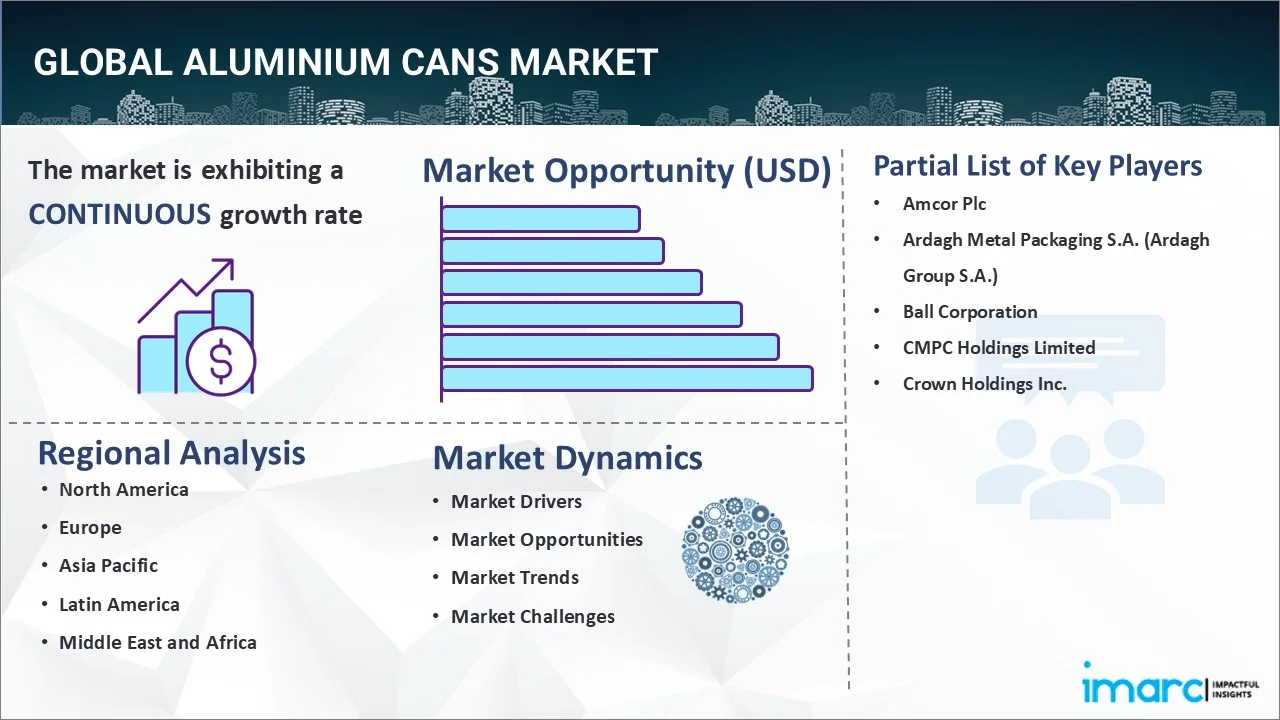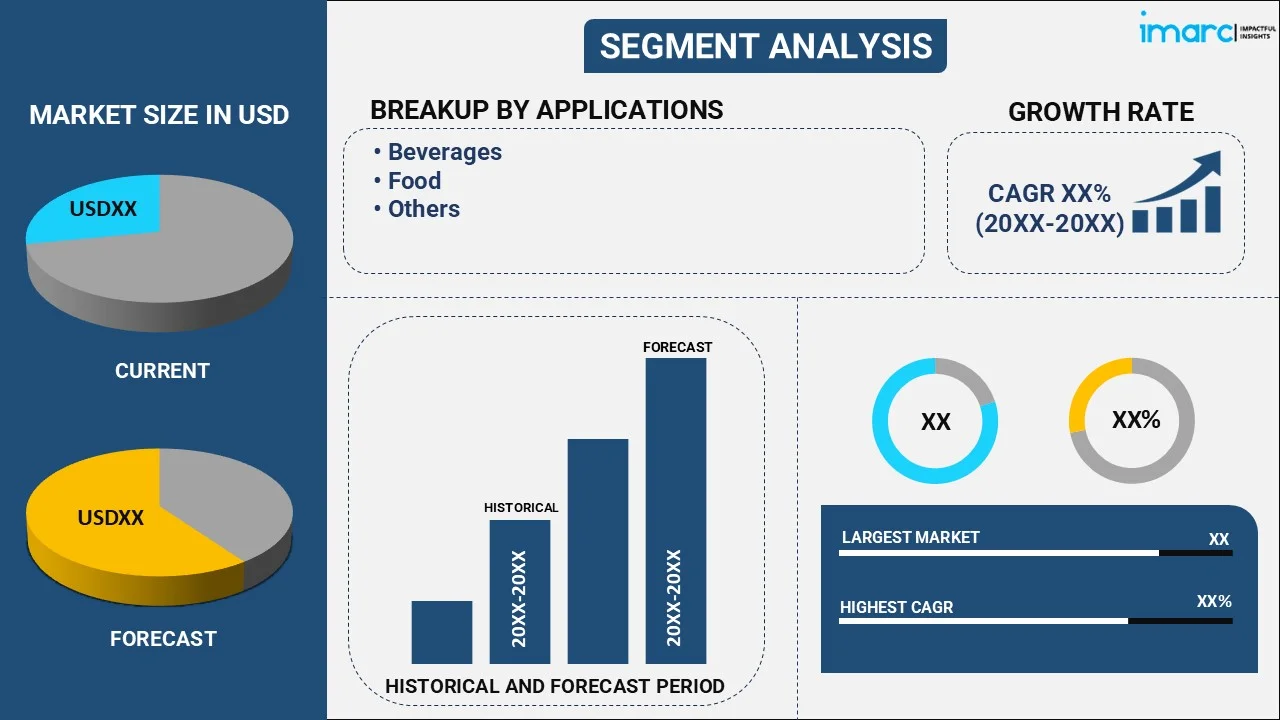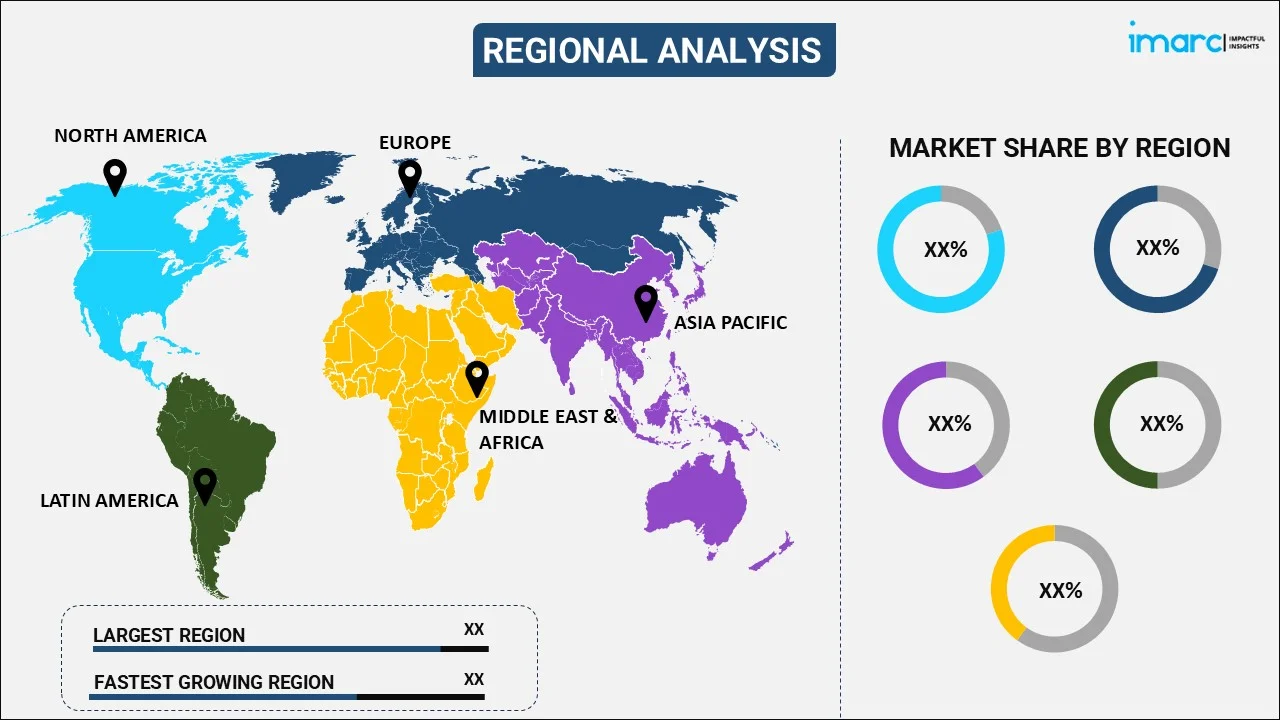
Aluminium Cans Market Report by Application (Beverages, Food, and Others), and Region 2025-2033
Market Overview:
The global aluminium cans market size reached USD 55.4 Billion in 2024. Looking forward, IMARC Group expects the market to reach USD 70.9 Billion by 2033, exhibiting a growth rate (CAGR) of 2.8% during 2025-2033. The rising environmental concerns, changing consumer preferences, and the utilization of 3D printing in the manufacturing processes are some of the major factors propelling the market. At present, North America holds the largest market share owing to exceptional growth in beverage and canned food consumption.
|
Report Attribute
|
Key Statistics
|
|---|---|
|
Base Year
|
2024 |
|
Forecast Years
|
2025-2033 |
|
Historical Years
|
2019-2024
|
|
Market Size in 2024
|
USD 55.4 Billion |
|
Market Forecast in 2033
|
USD 70.9 Billion |
| Market Growth Rate 2025-2033 | 2.8% |
Aluminium cans refer to containers primarily designed for packaging beverages and food items. They are formed through the process of extruding, trimming, and coating. They are widely used for soft drinks, beer, canned fruits and vegetables, energy drinks, tea, coffee, soups, aerosol sprays, and medicines. They are cost-effective, durable, and lightweight products that offer resistance to corrosion, high recyclability, and excellent barrier against light, oxygen, and moisture. Aluminium cans also provide several advantages, including rapid cooling ability, stackability, easy handling, low transportation costs, long shelf-life, and adaptability to various packaging designs.

The rising product demand owing to the introduction of diverse new beverages, food items, and consumer products requiring innovative packaging solutions is propelling the market growth. Furthermore, the utilization of three-dimensional (3D) printing in the manufacturing process, as it allows more efficient production, reduces lead times, and enables customization, is boosting the market growth. Besides this, the imposition of various government initiatives promoting the adoption of recyclable materials and sustainable practices is positively influencing the market growth. Moreover, the escalating health and safety concerns among the masses are facilitating product demand as it offers a superior ability to preserve content quality, maintain flavor integrity, and provide a long shelf life. Other factors, including growing expenditure capacities of consumers, increasing investment in the development of advanced manufacturing processes, and rapid urbanization, are anticipated to drive the market growth.
Aluminium Cans Market Trends/Drivers:
The rising environmental concerns
The growing awareness and emphasis on environmental sustainability are major driving forces in the aluminium cans market. Aluminium cans are recyclable and can be reused infinitely without losing quality. Furthermore, aluminium recycling saves most of the energy needed to produce the metal from its ores. As governments, organizations, and individuals increasingly prioritize reducing environmental impact, the demand for recyclable products has surged. Moreover, the presence of recycling facilities across the globe, coupled with the commitment to circular economy principles, underscore the potential for aluminium cans in reducing landfill waste. Additionally, various policies and regulations favoring recyclable materials further support this trend. The alignment of aluminium cans with environmental protection and sustainability goals is thus making them a preferred choice for both manufacturers and consumers.
The changing consumer preferences
The shift in consumer preferences towards convenient, lightweight, and sustainable packaging plays a pivotal role in driving the aluminium cans market. The rapidly changing consumer lifestyle is facilitating the demand for products that are easy to use, carry, and dispose of, such as aluminium cans. They are lightweight, portable, and recyclable products that offer consumers the advantage of quick cooling and unbreakable packaging, thus enhancing the overall user experience. Furthermore, the appeal of aluminium cans is broad, catering to various age groups and lifestyles, from outdoor enthusiasts to busy urban dwellers. Additionally, the branding and marketing opportunities provided by the customizable exterior of cans further align with the consumer's desire for aesthetically pleasing products. This alignment with contemporary consumer needs and desires ensures that aluminium cans remain a sought-after packaging option.
The economic factors associated with aluminium cans
Economic considerations significantly contribute to the growing popularity of aluminium cans in the market. The lightweight nature of aluminium translates into reduced transportation and handling costs. Lower weight means more cans can be transported in a single shipment, thus optimizing logistics and reducing fuel consumption. Furthermore, the cost of producing these cans has become more competitive due to technological advancements in manufacturing processes. The efficiency in production, combined with the recyclability factor, also contributes to cost savings. A well-established recycling infrastructure makes aluminium a cost-effective material in the long run. Additionally, its resistance to corrosion ensures that the integrity of the contained product is maintained, reducing the likelihood of wastage. These economic factors make aluminium cans an attractive option for businesses seeking to minimize costs while maintaining quality and aligning with environmental best practices.
Aluminium Cans Industry Segmentation:
IMARC Group provides an analysis of the key trends in each segment of the global aluminium cans market report, along with forecasts at the global and regional levels from 2025-2033. Our report has categorized the market based on application.
Breakup by Application:

- Beverages
- Food
- Others
Beverages dominates the market
The report has provided a detailed breakup and analysis of the market based on the application. This includes beverages, food, and others. According to the report, beverages represented the largest market segment.
Beverages are dominating the market as the lightweight and robust nature of aluminium cans makes it easy for manufacturers and consumers to handle, transport, and stack beverages. Furthermore, aluminium cans provide an impermeable barrier to light, oxygen, and moisture, which aids in ensuring the optimal taste and freshness of the beverages. Apart from this, the excellent heat conductivity of aluminium cans allows beverages to cool rapidly, thus enhancing the appeal for consumers. Besides this, with a growing focus on environmental sustainability, the high recyclability of aluminium cans aligns with both consumer preferences and regulatory demands. In addition to this, the ability to easily customize the shape and appearance of aluminium cans allows beverage companies to utilize them as marketing tools, creating distinctive branding.
Breakup by Region:

- Asia Pacific
- North America
- Europe
- Middle East and Africa
- Latin America
North America exhibits a clear dominance in the market, accounting for the largest aluminium cans market share
The report has also provided a comprehensive analysis of all the major regional markets, which includes Asia Pacific, North America, Europe, Middle East and Africa, and Latin America. According to the report, North America represented the largest market segment.
North America is dominating the market due to the high consumption rate of beverages and canned goods, driven by lifestyle preferences and convenience needs. Furthermore, the region possesses technologically advanced manufacturing facilities, enabling efficient production and innovation in aluminium can design. Additionally, the strong focus on environmental sustainability in North America is facilitating the demand for aluminium cans, owing to their recyclable nature, which aligns with both regulatory goals and consumer preferences for eco-friendly products. Moreover, the presence of well-established distribution and retail networks, which ensure the seamless supply of aluminium cans to various industries, is positively influencing the market growth. Besides, the imposition of favorable initiatives by the regional governments to encourage the adoption of recycled and sustainable packaging materials is contributing to the market growth. For instance, the United States Environmental Protection Agency plays a crucial role in endorsing sustainable practices in the industry. The EPA measures the generation, composting, recycling, combustion with recovery of energy, and landfilling of aluminum materials. Further, the efforts of the EPA to encourage waste reduction and recycling reinforce the demand for aluminum cans as an eco-friendly and recyclable packaging option.
Competitive Landscape:
The leading aluminium cans companies are investing heavily in creating innovative products. This includes designing new can shapes, sizes, and functionalities to meet evolving consumer needs. Furthermore, key market players are focusing on improving recycling rates, reducing energy consumption in manufacturing, and implementing more sustainable sourcing practices. Additionally, leading firms are pursuing opportunities in emerging markets, expanding their global footprint through acquisitions, joint ventures, and new facilities. Besides this, several key players are employing creative marketing and branding strategies, including collaboration with popular brands or leveraging unique packaging to attract customers. Moreover, they are focusing on optimizing supply chain operations to reduce costs and increase efficiency. This includes investing in advanced logistics technologies and forming strategic partnerships with suppliers and distributors.
The report has provided a comprehensive analysis of the competitive landscape in the global aluminium cans market. Detailed profiles of all major companies have also been provided. Some of the key players in the market include:
- Amcor Plc
- Ardagh Metal Packaging S.A. (Ardagh Group S.A.)
- Ball Corporation
- CMPC Holdings Limited
- Crown Holdings Inc.
Recent Developments:
- In June 2022, Ball Corporation announced that it is expanding its operation in South America by establishing a new manufacturing facility for aluminium cans in Peru.
- In April 2022, Crown Holdings, Inc. announced that it is constructing a new high-speed aluminum can line at its beverage can facility in Agoncillo, Spain.
- In May 2023, Ardagh Group S.A. and Crown Holdings announced that they are funding a new grand opportunity as part of their efforts to spur the installation of additional aluminum can-capture equipment in material recovery facilities (MRFs).
Aluminium Cans Market Report Scope:
| Report Features | Details |
|---|---|
| Base Year of the Analysis | 2024 |
| Historical Period | 2019-2024 |
| Forecast Period | 2025-2033 |
| Units | Billion USD, Billion Units |
| Scope of the Report | Exploration of Historical and Forecast Trends, Industry Catalysts and Challenges, Segment-Wise Historical and Predictive Market Assessment:
|
| Applications Covered | Beverages, Food, Others |
| Regions Covered | Asia Pacific, Europe, North America, Latin America, Middle East and Africa |
| Companies Covered | Amcor Plc, Ardagh Metal Packaging S.A. (Ardagh Group S.A.), Ball Corporation, CMPC Holdings Limited, Crown Holdings Inc. |
| Customization Scope | 10% Free Customization |
| Post-Sale Analyst Support | 10-12 Weeks |
| Delivery Format | PDF and Excel through Email (We can also provide the editable version of the report in PPT/Word format on special request) |
Key Benefits for Stakeholders
- IMARC’s report offers a comprehensive quantitative analysis of various market segments, historical and current market trends, market forecasts, and dynamics of the aluminium cans market from 2019-2033.
- The research study provides the latest information on the market drivers, challenges, and opportunities in the global aluminium cans market.
- The study maps the leading, as well as the fastest-growing, regional markets.
- Porter's five forces analysis assist stakeholders in assessing the impact of new entrants, competitive rivalry, supplier power, buyer power, and the threat of substitution. It helps stakeholders to analyze the level of competition within the aluminium cans industry and its attractiveness.
- Competitive landscape allows stakeholders to understand their competitive environment and provides an insight into the current positions of key players in the market.
Key Questions Answered in This Report
The global aluminium cans market reached a value of USD 55.4 Billion in 2024.
According to the estimates by IMARC Group, the global aluminium cans market will exhibit a CAGR of 2.8% during 2025-2033.
With growing environmental concerns, leading manufacturers are now utilizing recyclable product packaging, which, in turn, is escalating the demand for aluminium cans around the world.
A surge in demand for canned beverages and supply shortage of aluminium cans due to lockdowns imposed by governments of several countries to curb the spread of the coronavirus disease (COVID-19) is hampering the market growth.
An increase in the sales of ready-to-drink beverages on account of rapid urbanization, hectic lifestyles and inflating income levels represent one of the key factors bolstering the market growth.
The market has been divided on the basis of the application into beverages, food and others.
On the geographical front, the market has been segmented into North America, Europe, Asia Pacific, Latin America, and Middle East and Africa.
Leading industry players are Amcor Plc, Ardagh Metal Packaging S.A. (Ardagh Group S.A.), Ball Corporation, CMPC Holdings Limited and Crown Holdings Inc.
Need more help?
- Speak to our experienced analysts for insights on the current market scenarios.
- Include additional segments and countries to customize the report as per your requirement.
- Gain an unparalleled competitive advantage in your domain by understanding how to utilize the report and positively impacting your operations and revenue.
- For further assistance, please connect with our analysts.

 Inquire Before Buying
Inquire Before Buying
 Speak to an Analyst
Speak to an Analyst
 Request Brochure
Request Brochure
 Request Customization
Request Customization



.webp)




.webp)












